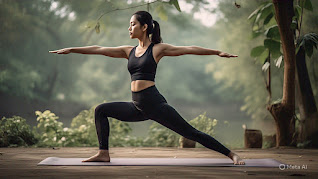In today’s fast-paced world, stress, fatigue, and restlessness have become common parts of everyday life. But there’s an ancient practice that offers calm amidst the chaos — Yoga. Whether you’re looking to reduce stress, improve flexibility, or simply become more present, yoga is a powerful, holistic path to better health. And the best part? Anyone can start — at any age or fitness level.
What Is Yoga?
Yoga is a 5,000-year-old practice from India that
means “union” — the union of body, mind, and spirit. It combines physical
postures (asanas), breathing techniques (pranayama), and meditation (dhyana) to
promote overall well-being.
Yoga isn’t just about twisting your body into
shapes. It’s about becoming more aware of your body and mind and learning to
live in the present moment.
Why Beginners
Should Try Yoga
If you're new to yoga, don’t worry — you don’t
have to be flexible or fit to begin. Yoga meets you where you are. It’s not
about perfection; it’s about progress and presence.
Some key benefits for beginners include:
- 🧘♂️ Improved flexibility and strength
- 🌿 Reduced stress and anxiety
- ❤️ Better heart and lung health
- 😌 Calm mind and improved focus
- 💤 Better sleep quality
Even 15–20 minutes of daily practice can bring
visible changes in your mood, posture, and energy levels.
Simple Yoga Poses
for Beginners
If you’re just starting, begin with these gentle,
accessible poses:
- Mountain Pose (Tadasana) – A
grounding standing pose to align the body.
- Child’s Pose (Balasana) – A resting
pose that stretches the back and relaxes the body.
- Cat-Cow Pose (Marjaryasana-Bitilasana) – Helps improve spine flexibility and warms up the body.
- Downward-Facing Dog (Adho Mukha Svanasana) – A gentle inversion that stretches the legs and spine.
- Seated Forward Fold (Paschimottanasana) – A calming stretch for the back and hamstrings.
- Corpse Pose (Shavasana) – A final
relaxation pose that promotes deep rest.
Start with 3–5 rounds of each pose, breathing slowly
and deeply. Use a yoga mat, blanket, or cushion for added comfort.
Tips Before You
Begin
- 🔹 Start slow – You don’t need to master everything at once.
- 🔹 Listen to your body – Never force a pose. If it hurts, stop.
- 🔹 Wear comfortable clothes – Choose breathable, stretchy
fabrics.
- 🔹 Create a calm space – A quiet corner of your room is enough.
- 🔹 Practice on an empty stomach – Or at least 2–3 hours after
eating.
- 🔹 Stay consistent – Even 10 minutes daily is better than once a
week.
Breathing Matters
In yoga, breath is everything. Practicing
simple breathing techniques like deep belly breathing, alternate
nostril breathing (Nadi Shodhana), or 4-7-8 breath can calm your
nervous system and improve focus.
Start by just sitting quietly and observing your
breath for a few minutes each day.
Should You Join a
Class?
While self-practice is possible, joining a beginner-friendly
yoga class (online or in person) has benefits:
- You learn correct alignment and technique
- You’re guided by experienced teachers
- You get motivation and community support
Choose styles like Hatha Yoga or Gentle
Flow for a beginner-friendly pace.
Yoga Is Not a
Competition
In a world obsessed with speed and results, yoga
invites you to slow down, feel, and be kind to yourself.
There’s no race to touch your toes or balance on your head.
What matters is your intention, consistency,
and the peace you carry off the mat.
Final Thoughts
Yoga is more than just a workout — it’s a way of
living with awareness and grace. As a beginner, the most important thing is
to begin with an open heart and a willing spirit. Don’t worry
about how you look. Focus on how you feel.
Over time, you’ll notice not just physical
improvements, but a deeper connection to yourself and the world around you.
So unroll your mat, take a deep breath, and take
your first step toward a healthier, happier you.
Namaste 🙏




No comments:
Post a Comment